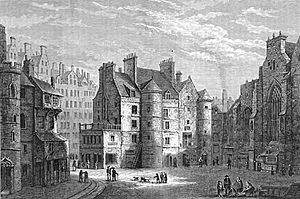John Urry (soldier) facts for kids
Quick facts for kids
Sir
John Urry
|
|
|---|---|

Old Tolbooth, Edinburgh c. 1750; Urry was executed on the platform at left centre
|
|
| Personal details | |
| Born | Pitfichie, Monymusk, Aberdeenshire |
| Died | 29 May 1650 Edinburgh |
| Cause of death | Beheading |
| Nationality | Scottish |
| Occupation | Soldier |
| Military service | |
| Years of service | 1639 to 1650 |
| Rank | Major General |
| Battles/wars | |
Sir John Urry, also known as Hurry, was a Scottish soldier. He fought in many battles during the Wars of the Three Kingdoms. These wars involved different groups like the Scottish Covenanters, Engagers, and Royalists. He also fought for both the English Parliamentarians (Roundheads) and Royalists (Cavaliers). Sir John Urry was captured in April 1650 and was put to death in Edinburgh on May 29, 1650.
Contents
About John Urry
John Urry was born in Pitfichie, near Monymusk, in Aberdeenshire, Scotland. His father was also named John Urry. His mother was Mariora Cameraria, or Marian Chamberlain. He had a brother, Sir William Urry. William's son, also named John, became a well-known editor of books.
A Soldier's Life
Like many Scots of his time, Urry started his military career in the Thirty Years War. He likely fought with the Swedish army in Germany.
Fighting for the Covenanters
He returned to Scotland to join the Bishops' Wars in 1639 and 1640. He became a Lieutenant-Colonel in a Covenanter army. The Church of Scotland (known as the kirk) was important for Scottish independence. Urry seemed to fight more for his country than for religious reasons.
The Covenanters won the war at Newburn in August 1640. In late 1641, Urry helped stop a Royalist plan called the "Incident." For this, he was given command of a group of horse soldiers in June 1642. This army was formed by the English Parliament. It was meant to stop the Irish rebellion of 1641.
Changing Sides in the English Civil War
Before he could go to Ireland, the First English Civil War began in August 1642. Urry helped Sir William Waller capture Portsmouth. This city was held by Royalist soldiers. He then joined the main Parliamentarian army. He fought at the Battle of Edgehill in October and Brentford in November.
In June 1643, Urry switched sides and joined the Royalist army in Oxford. This happened because he reportedly did not get a promotion he wanted. He gave the Royalists information about a Parliamentarian convoy carrying money. He joined Prince Rupert's force to try and capture it. They did not find the money, but they did get a lot of goods. They also defeated a chasing army at Chalgrove Field.
Urry was rewarded with a knighthood. He fought under Prince Rupert at the Battle of Marston Moor in July 1644. There, he led the cavalry on the Royalist left side. Even though they fought well, the Royalists lost badly. In August, Urry switched sides again. He joined the Parliamentarian army in Shrewsbury.
Back with the Covenanters
Urry was arrested and sent to London. But he was released because Sir William Waller said his military skills were very important. Parliament allowed him to join the Covenanter army in North East England. This army was led by the Earl of Leven.
In February 1645, Urry went back to Scotland as a Major General. He served with William Baillie against Montrose. This was during the 1645 Highland campaign.
Urry's separate military actions were very skillful. However, an attempt to surprise Montrose at Auldearn in May 1645 failed. His soldiers fired their guns to clear damp powder in heavy rain. This warned the Royalists, who then launched a strong counter-attack. Urry lost almost half his men and resigned due to illness.
Final Loyalty and Capture
In June 1648, a group of Covenanters called the Engagers agreed to bring back King Charles I. They entered the Second English Civil War. Urry joined the Scottish army but was captured at Preston in August.
He managed to escape to the Dutch Republic. He joined the exiled court of Charles II. Charles II was named King by the Kirk Party after his father, Charles I, was executed in January 1649. However, this came with conditions. Charles II wanted to avoid giving up too much power.
Charles II encouraged small Royalist uprisings in Scotland. On February 20, 1649, he made Montrose the main commander in Scotland, with Urry as his second-in-command. But many of Charles's advisors did not trust Montrose. They thought this plan would fail and weaken Charles's position.
The uprising did not get much support in Scotland. It ended in defeat at the Carbisdale in April 1650. Montrose and Urry were captured. The Scottish government forced Charles II to disown them. Montrose was executed on May 12. Urry was put to death outside the Old Tolbooth, Edinburgh on May 29.
One historian, Trevor Royle, said that Urry "strove to give his best service to whoever was paying him at the time." But he could never decide which side to support, and this cost him his life.

